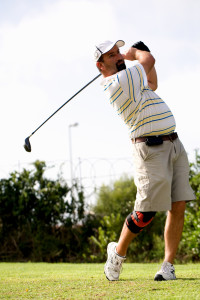 Golf is not at all an easy sport. Proper technique and conditioning is essential to not only improving golf performance but also to minimise the risk of injury. Low back injuries are particularly common amongst players, accounting for 63% of all injuries in professional golfers.
Golf is not at all an easy sport. Proper technique and conditioning is essential to not only improving golf performance but also to minimise the risk of injury. Low back injuries are particularly common amongst players, accounting for 63% of all injuries in professional golfers.
Are you suffering an injury that is preventing you from enjoying your golf? Do you want to improve your golf performance? If so, call the practice now on (08) 61508785 Scarborough or (08) 61508783 Mount Pleasant to arrange an appointment.
Preventing Golf Injuries
To prevent injury and maximise your swing follow these tips:
- Are you adequately warmed up? We’re not just talking about an hour beforehand, but right before you hit that first tee as well! The first drive requires a complex series of movements that can put 8 times your body weight through your spine! That complex series requires a nervous system that has been primed!
- Work on your flexibility. Obviously there is a lot of side bending and shearing involved with the swing and it is important to have enough flexibility to allow these movements to occur without straining your muscles, tendons, ligaments or discs.
- Work on your stability. Core strength is essential to not only minimising the risk of low back pain but also controlling your swing. Without good core stability you can injure your back and not be able to generate the same amount of power.
- Work on your full body strength. Golf is not just about the low back- professional golfers need to work on all muscle groups! Make sure you are working on strengthening your gluteals, thighs, rotator cuff and forearms amongst others.
- Do exercises that are specific to golf movements. Many golfers enjoy many different types of sport. However, if you want to get serious about improving your game it’s important to understand the concept of specificity. Your training regime should target the movement patterns that are used in golf so that your body becomes not just fit, but ‘golf-fit’. Focus on the obliques (cable work), quadratus lumborum (side planks) and gluteals with squats (body weight) and stretches that involve spiral (torsion) patterns.
Fixing Golf Injuries
At Spine Scan we can work with you to individualise your training and help prevent pain and other injuries. Our chiropractor, Dr Rocchi, uses two main treatment systems. The first one is the Spine Scan handheld computerised instrument. This instrument and associated software identifies stiff or locked vertebral segments and delivers a series of high velocity, small amplitude impulses into the taut musculature along the spine. The reduction in tension in the tissue along the spine can be seen both on the screen and, more importantly, immediately after with significantly improved range of motion. How does a full backswing and follow-through sound?
Secondly, Dr Rocchi uses the Trigenics technique. This is a treatment that aims to stimulate nerve receptors within the muscles whilst you perform specific movements. This technique can improve the way your muscles communicate with the brain and the way the brain communicates with your muscles. It normally becomes obvious at the first visit with noticeable improvements in strength, which is always pleasing. The power generated from the large side muscles are enormous however it is sadly common to find these muscles not responding when challenged at the office.
Call the practice (08) 61508783 to arrange an appointment.


No comments yet.